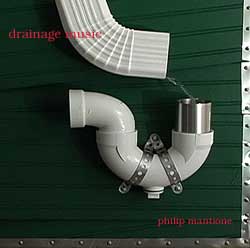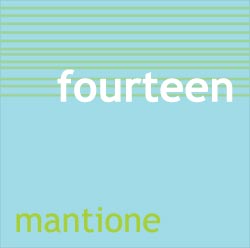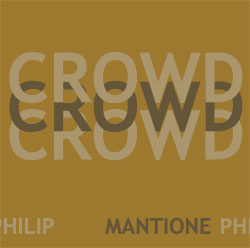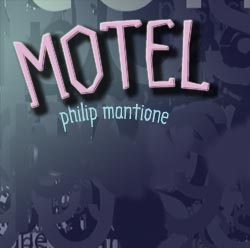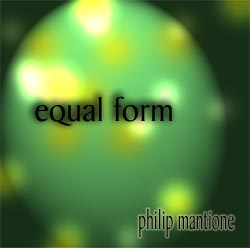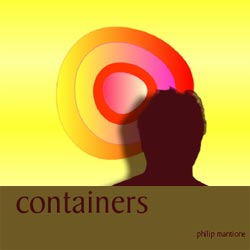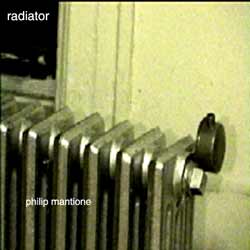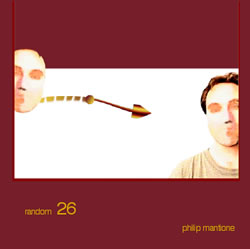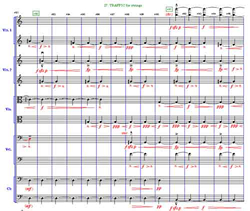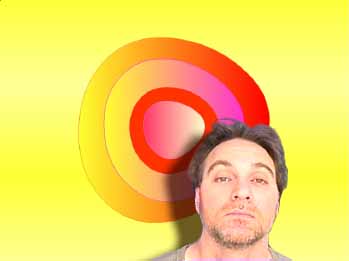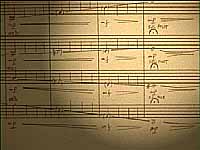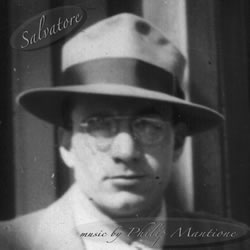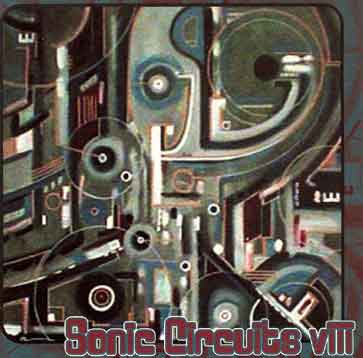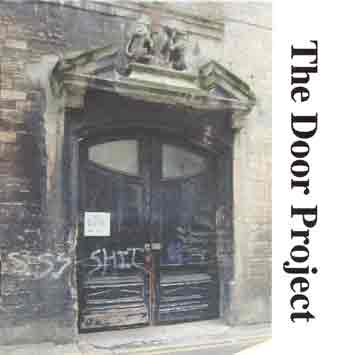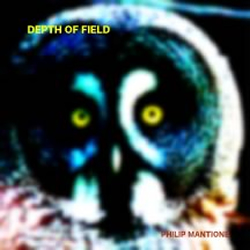
|
Music available for download at philipmantione.bandcamp.com
Depth of Field
... is a collection of work created over the past two years using field recordings and computer generated sounds. The title draws a sonic parallel with photography and visual imagery in terms of the relative clarity or presence of background and foreground content and the interplay and movement between the two ideas.
Downloads available @ philipmantione.bandcamp.com
1. Depth of Field (7:13) - 2011 - based on a field recording of hoot owls in Riverside, CA - 3:00am - Nov. 2011
2. Social Immune System (9:58) - 2011 - based on field recordings at an Occupy LA protest - Oct. 15, 2011 (16-Channel version premiered at the Centre de Cultura Contemporània in Barcelona (CCCB)
3. HFone (6:06) - 2011 - various samples manipulated with custom software written in MAX/Msp called "Headfuck"
4. HFtwo (5:52) - 2011 - same as above
5. Fabrics (8:42) - 2010 - computer generated music manipulated with custom software (Premiered in FILE 2011 at the SESI' Cultural Centre in San Paulo, Brazil)
6. Valuri (7:00) - 2010 - same as above - (Premiered as part of the "Wet Sounds" installation at several locations in the UK organized by Joel Cahen)
7. Dialtone and Strings (9:10) - 2009 - based on samples of telephone sounds and a string orchestra piece called "Traffic for strings" (Premiered as part of SoundLab VII, part of the [NewMediaArtProjectNetwork]:||cologne
SCATTERED CD 111
© 2009 - 2011 Philip Mantione
All Rights Reserved |
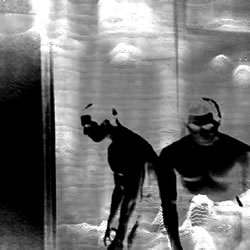
|
It's ALIVE!
Philip Mantione in Santa Fe
A collection of music created in Santa Fe including work for experimental video and live rercordings of multimedia performances, a kinetic sound installation and experiments with improvisation-based ensembles.
Downloads available @ philipmantione.bandcamp.com
1. ImXCocteau (12:50)
© 2008 Philip Mantione
Soundtrack for the video by Alysse Stepanian. Material includes soprano sax samples taken from recordings of Eric Roberts and field recordings made in Santa Fe (Eldorado area)
2. T=2.7k - Beginning - Excerpt 1 (3:00)
3. T=2.7k - Ending - Excerpt 2 (2:58)
© 2008 Philip Mantione
Two excerpts from T = 2.7k, a multimedia performance that featured improvisations by trumpeter Ron Helman, video by Alysse Stepanian and computer interactive devices invented by Philip Mantione. These excerpts are from a 45 minute piece that includes interactive performance, computer controlled kinetic devices, and improvisation using triggered samples of field recordings made in Beijing, Barcelona, Berlin and upstate NY. October 2008 - Center for Contemporary Art, Santa Fe, New Mexico.
4. Larghetto - Excerpt 1(4:25)
5. Larghetto - Excerpt 2 (2:21)
Two excerpts from Larghetto, a live improvisation by Philip Mantione and Martin Back using hacked electronic devices, amplified metronome and suspended cymbal. General types of actions were predetermined and a chronomter was used to begin or end processes at specific times. Mantione performed on The Human Resistor, an electronic instrument he created from an answering machine, two intercoms, and two electronic toys. Towards the end of the performance, a copper pipe was attached to the device via jumper cables, and audience members were invited to participate in the piece through physical contact with the pipe. Ultimately, by holding hands, a chain of people formed, creating a multi-person human resistor. November 2008 - Santa Fe Complex, Santa Fe, New Mexico.
6. Random Textures (15:02)
© 2008 Philip Mantione
Superimposition of four separate recordings of Random Textures, a structured improvisation-based piece performed by the Ancestral Groan Liberation Orchestra (AGLO), directed by Martin Back. Players include: Martin Back, Samuel Cobean, David Hevener, Philip Mantione, Lisa McKenna, Walter Menetrey, Christian Pincock, Frank Rolla, and Julie West. Scored for eight parts, each player is given verbal indications related to duration, density, and dynamics. A chronometer is used to regulate the 15 minute total duration and each performer plays a different number of sections of equal length within that time. Since the piece is exactly 15 minutes long, it was possible to superimpose multiple recordings and create serendipitous sonorities that would not have normally occurred. December 2008 - Santa Fe, New Mexico.
7. FrankenCircuit - Excerpt (2:02)
Audio documentation excerpt from a collaborative multimedia installation called FrankenCircuit, organized and curated by Philip Mantione. Kinetic sound sculptures created by Martin Back, Tristan Chambers, Tory Hughes, Philip Mantione, David McPherson, Zevin Polzin, and Frank Rolla were all activated simultaneously by a large FrankenSwitch. Audio documentation by Jason Goodyear. Video by Dr. Woohoo, Alysse Stepanian, and Woody and Steina Vasulka. June 2009 - Santa Fe Complex, Santa Fe, New Mexico.
8. UUUUT Experiment - Excerpt 1 (5:05)
9. UUUUT Experiment - Excerpt 2 (6:33)
Two excerpts from the superimposition of three separate performances of The UUUUT Experiment (<65dB), a bi-monthly experiment in free improvisation organized by Mantione. The only rule in these sessions is that the overall sound pressure level should not exceed 65dB for any extended period of time. This is monitored by a projected decibel meter created in MAX/Msp. Players include: Aku, Martin Back, James Brody, Daniel Drell, David Forlano, Ross Hamlin, Victoria Hughes, Courtney Kerr, Orlando Leibovitz, Philip Mantione, David McPherson, Nick Najdowski, Paul Paryski, Anne Rocheleau, Frank Rolla, Mike Root, Patricia Sauthoff, Alysse Stepanian, and Dave Wayne. Sound Engineers: Darryl Frank and Stephen Schmidtt. March to June 2009 - Santa Fe, New Mexico.
SCATTERED CD 110
(cover image: © 2009 Alysse Stepanian) |
|
Drainage Music
Music for Drainage: an interactive installation with gravity-driven mechanics, sound, sculpture
and video created by Alysse Stepanian and Philip Mantione.
Downloads available @ philipmantione.bandcamp.com
1. Melt (1:52)
Based
on samples of snow melting off a roof and a kinetic sculpture called Ca
Ching
2. AcGtr (6:34)
Based
on acoustic guitar samples.
3. Dog(3:26)
Based
on samples of Kayo the dog.
4. Random Gestures(4:31)
Based
on random guitar, voice, and dog samples.
5. Dusk(8:58)
Manipulated
field recording at dusk in Bloomingburg, NY
SCATTERED CD 109
cover and logo design:
© 2004 Alysse Stepanian
cover image: “Desire” (sculpture with drain pipes, water,
pump,
flashing on wood panels)
© 2004 Philip Mantione
music: © 2004 Philip Mantione
|
|
fourteen
A collection of
work based on field recordings, filtered noise, and various other
samples.
Downloads available @ philipmantione.bandcamp.com
1. Track 1 (2:34)
2. Track 2 (3:37)
3. Track 3 (4:24)
4. Track 4 (2:21)
5. Track 5 (2:27)
6. Track 6 (4:21)
7. Track 7 (3:18)
8. Track 8 (4:30)
9. Track 9 (4:02)
10. Track 10 (2:36)
11. Track 11 (3:07)
12. Track 12 (3:46)
13. Track 13 (2:50)
14. Track 14 (3:00)
SCATTERED CD 108
cover and logo design:
© 2003 Alysse Stepanian
music: © 2003 Philip Mantione
|
|
Crowd
Music derived
from field recordings of two peace demonstrations in NYC and the Macy's
Thanksgiving Day Parade.
Downloads available @ philipmantione.bandcamp.com
1. Chant (7:39)
2. Sound (7:16)
3. Voice (8:09)
4. Rhythm (7:03)
5. Ambience (2:44)
SCATTERED CD 107
cover and logo design:
© 2002 Alysse Stepanian
music: © 2002 Philip Mantione |
|
Motel
Download available @ philipmantione.bandcamp.com
1. motel (15:12)
In July of 2001, One Night Stand, an art show, was curated by Tamara Fites
and Michael Lewis Miller at the Farmer’s Daughter Motel in Los Angeles.
In this show, I set up a 3-hour live telephone connection from New York
City to one of the motel rooms, and recorded comments and/or sounds made
by anyone who chose to pick up the receiver. Conversational fragments
were later dissected, recontextualized and warped into droning and rhythmic
sonic backdrops to create motel.
SCATTERED CD 106
cover and logo design:
© 2001 Alysse Stepanian
music: © 2001 Philip Mantione
|
|
Equal Form
A collections of
pieces that are part of an ongoing series in which I randomly juxtapose
discrete sections of equal duration in time... a sort of equal form.
Each section is drone-like or homogeneous in timbre or rhythmic content,
and is abruptly interrupted by the next. Paradoxically, it is within
this seemingly rigid architecture that I believe the listener is free
to experience time on their own terms.
Downloads available @ philipmantione.bandcamp.com
1. Five (7:35)
Five drones.
2. Dorr (4:00)
Based on the sound of the creaking men’s room door at the ICMC in
Berlin. The sample used was recorded by John FFitch.
3. Elizabeth (4:12)
The source material for the piece is comprised of recorded samples of
the bagpipes as performed by Elizabeth Nixon. The music was also used
in the soundtrack for an experimental video called Buffalo, in
collaboration with visual artist, Alysse Stepanian.
4. White, pink, regular and unknown (14:39)
Various types of noise.
SCATTERED CD 105
cover and logo design:
© 2001 Alysse Stepanian
music: © 2001 Philip Mantione
|
|
Containers
John Cage treated
musical form as an “empty container” and in many of his pieces
used a structure based on a series of proportionally related sections.
The work found here also focuses on the idea of temporal “containers”
but instead of enforcing a proportional scheme or macro-rhythm, they
allow for a listener-derived form. Sections of equal length but usually
varied textures are juxtaposed in time. The reality of temporal space
becomes a function of the perceived interestingness of the material
at any given moment. Translation: Time flies when you’re having
fun...or not.
Downloads available @ philipmantione.bandcamp.com
1. Sinusoidal Tendencies (9:54)
In this piece I randomly juxtaposed discrete sections of equal duration
in time. Each section is a mini-drone that evolves slowly until it is
abruptly interrupted by the next. I wrote a program using MAX/MSP to generate
and manipulate sixty sine waves. Within each section, the frequency of
individual waves is fixed, however, each is subjected to continually shifting
amplitude curves. Frequency distributions were configured within a constrained
randomness or loosely centered around harmonic, logarithmic, or exponential
continuums. Intentional clipping was used to create indeterminant harmonic
effects.
2. Reunion (9:59)
Reunion was originally written as the sound track for Alysse Stepanian’s
video of the same name. The source material consists largely of samples
of an old brass film spool being struck, claves, and guitar harmonics.
The architecture of the piece involves three consecutive 3:20 drones,
upon which eleven shorter sections (:54) are layered.
3. Two Minutes (2:00)
The source for the piece is a recording of the phrase, “Two minutes
can be a long time.” The material was manipulated utilizing a patch
I wrote in MAX/MSP, and the phase vocoder found in Tom Erbe’s, Sound
Hack program.
4. Country Inn (6:06)
Country Inn was originally written as the sound track for Alysse
Stepanian’s video of the same name. Atypically, I chose to use stock
samples from the Roland JV-1010 in this piece. Rather than focusing on
sample manipulation, this work utilizes a patch written in MAX that harmonically
morphs between two mutually exclusive hexachords while applying random
parameters to chord size, rhythm and dynamics.
SCATTERED CD 104
cover and logo design:
© 2000 Alysse Stepanian
music: © 2000 Philip Mantione
|
|
Radiator
Radiator (26:30) is music based on the sound that a radiator makes as it
begins to heat up. Trapped moisture produces a random banging sound,
accompanied by the hissing of steam. The first part of the work is comprised
of computer manipulated samples of this sound, presented as discrete
cells of identical length (20 seconds), and placed adjacent to each
other in time. This creates a macro-rhythm dictated by a sequence of
mini-drones, in which perceived duration becomes a function of sonic
density and rhythmic complexity. Later in the work, drone sounds from
previous works (both acoustic and electronic) are layered over the ongoing
radiator samples, further complicating the perception of time.
Download available @ philipmantione.bandcamp.com
SCATTERED CD 103
cover and logo design:
© 1999 Alysse Stepanian
music: © 1999 Philip Mantione
|
|
Random 26
Since music is manifested in temporal space,it is undeniably an art of process, but it also has the ability to create objects in the memory of the listener. Given an awareness of current thoughts on chaotic processes and a fascination with the human mind’s capacity for memory, perception and projection, writing music that explores these areas has been irresistible. My compositional process has involved using the computer as both a tool and an instrument in the discovery of an underlying musical cohesiveness and the subsequent accentuation of unifying elements, within the celebration of the multiplicity of random events.
Downloads available @ philipmantione.bandcamp.com
1. Frame of Reference (6:02)
2. Sawfly(6:03)
3. Antidepressant (6:02)
4. Samovar(6:03)
5. Climatology(6:01)
6. Paralyse (30:01)
SCATTERED CD 102
cover and logo design:
© 2000 Alysse Stepanian
music: © 1999 Philip Mantione |
|
Traffic for strings
Traffic for strings (10:00) is based on a time expanded version
of the original structure used in Traffic for brass quintet. Timbral and dynamic choices, pitch distributions,
and the way in which time is perceived in the work reflect an aesthetic
borne from my experience in the manipulation of sound and time and the use
of random processes in computer music.
Recorded live at Merkin Hall in NYC and performed by the S.E.M. Ensemble, Petr Kotic conducting.
© 2005
Philip Mantione |
|
Traffic
...for brass quintet is based on pitches and rhythms derived from a transcription of a field recording of traffic sounds in NYC. The original durations from the transcription were expanded many times over and intuitive choices influenced the orchestration for brass regarding octave displacement, timbral manipulation and dynamics. The result is an eight minute soundscape where individuals emerge from and recede into a texture of largely sustained harmony, anarchic in its origins but fixed in its present form. The same underlying structure was used as the basis for Traffic for strings, a piece for string orchestra premiered at Merkin Hall in NYC by the SEM Ensemble, conducted by Petr Kotik.
© 2003
Philip Mantione
|
|
Brass Quartet
Brass Quartet is based on melodic fragments chosen at random. The sharp attack unique to brass instruments is exploited through the simultaneous use of repeated notes that accelerate in one line, slow down in another, and remain constant in another, creating rhythmic and timbral complexity. Throughout the piece, polarized ideas of meter, texture and dynamics stubbornly coexist.
music: © 1995 Philip Mantione |
E Pluribus, Pluribus
E Pluribus,Pluribus is for any five, pitched instruments and tape which includes randomly placed and panned fragments from recorded live performances of previous works. Although players are given a specific number of notated pitches to perform within each time period, the actual sounding pitches and timbre will vary depending on the instruments used. The underlying structure is based on relative intervallic distances, specific sectional durations, and contrasting articulation and dynamic indications.
© 1997 Philip Mantione
|
|
Ochlokratia
Ochlokratia for orchestra incorporates computer generated random events that provide the foundation for harmonic, melodic and rhythmic content. Aleatoric devices are used to create complex and chaotic rhythmic textures. Shifts from metered to non-metered music and their coexistence define states of flux or stasis. The title of the piece, Ochlokratia, was chosen at random from Webster's Dictionary. It is the Greek root of the word ochlocracy, defined as government by the mob or mob rule.
image: Ochlokratia, 1996, pencils, graphite, and nails on wood
© 1996 Philip Mantione
© 1996 Philip Mantione |
|
Random 25
In Random 25 for string quartet, constantly shifting timbres and microtonal colors evolve as the consensual timein the beginning of the piece, gives way to an independent or individual notion of temporal space.
Performed at Dixon Place in NYC by the Kaleidoscope String Quartet
© 1999 Philip Mantione |
|
Salvatore
1. Earthquake V1 (10:20) - (2013)
The structure of Earthquake V1 and V2 is derived from earthquake data recorded in California and Nevada during a 24 hour period on 3/23/13, culled from the Southern California Earthquake Data Center at the California Institute of Technology. The duration and temporal placement of seismic events were condensed from the 24 hour period down to 10 minutes. The magnitude, geographic location and depth were used to determine the volume, spatial location, sample choice and/or computer generated sound. These works are spatialized for binaural playback and best heard with headphones.
Earthquake V1 is composed of looped samples made largely with contact microphones which include pins dropping in metal and glass containers, sounds created with a handmade aeolian harp, paper being torn, a ceramic tile being scrapped across concrete and spinning coins. The rumble is a manipulated sample of leaves being crunched.
2. Earthquake V2 (10:03) - (2013)
Earthquake V2 is composed of sounds generated by a synthesizer programmed in Max/MSP that utilizes oscillators, wavetables, envelopes and samples as modulation and sound sources. As in V1, Earthquake data was used to determine entrances of new material over the course of the piece.
3. Deadman Overlook (9:56) - (2012)
This material was originally part of a collaborative sound installation with Daniel Eaton and realized on Mulholland Drive in Los Angeles, California. Eaton wrote separate material based on a predetermined form and each piece was played simultaneously via car stereo speakers at the site. This piece respresents my contribution in a combined form.
4. Human Resistor (15:00) - (2013)
Human Resistor is named after a bent circuit device I built using repurposed consumer electronic circuit boards wired together with random connections and ganged to single audio ouput. The device is activated by physical contact with hands, feet and mouth. The output was manipulated using custom software written in Max/MSP. All content is derived from The Human Resistor with the exception of the drone, built from orchestral samples, that enters at 3:32 and is gradually pitched shifted upwards over the course of 11 minutes. Several overlapped gestural improvisations, looped samples of the device and the drone combine to form three distinct layers of activity. Sounds seem to struggle to reach the foreground, only to be quickly swallowed up by the dense texture and spectral masking. The ever-rising drone creates a tension that is never resolved. This statement is a description of what resulted from a process, rather than that of a manfestation of some preconceived intent. The piece was originally written for Hidden Sounds, an internet radio show on basic.fm hosted by Rodger Boyle. (http://www.basic.fm/the-hidden-sounds/)
N.B. - The title of this collection, Salvatore, is named in honor of my father, who passed away on August 13, 2013 after a long battle with Alzheimers disease.
Available at Petroglyph Music (148) |
|
Sonic Circuits VIII
A
collection of work compiled by Sonic Circuits, sponsored by the Amercian
Composers Forum and Innova Recordings. Included are works by John
von Seggern, Katherine Gordon, Francis Dhomont, Preston Wright, Malte
Steiner, Philip
Mantione, Michael Hosch, David Jaggard, and Antun Toni Blazinovic.
Executive Producer:
Philip Blackburn
© 2000 Amercian Composers Forum
Available at Innova
Recordings (Innova 117) |
|
The Door Project
The
Door Project is a collection of work compiled by John
ffitch. Music created from the sound of the door of the Gentlemen's
toilet opening and closing at the ICMC
2000 meeting in Berlin. Included are works by Giannoulakis, Woodman,
Castine, DiBenedetto, Anon, Devaney, ffitch, Solare, Barass, Penttinen,
Beatsystem, Covell, Lopez, Mantaloni, Rhoades, Tao, Steiner, Smallwood,
Akkan, Rutz, Fogar, Mantione,
Herrera, and Rajchenberg.
Produced by John
ffitch
© 2001 The Composers
All rights reserved
Published by Alta Sound
Codemist Ltd -
Alto 02 CD |
Miscellaneous Works
Non_1_to_12 is a series of non works: non-musical, non-textual, non-performative, non-durational, non-material, non-instrumental, non-experimental, non-action, non-consensual, non-explained, non-fluxus, non-silence, non-sound, non-cochlear, non-noise, non-object, non-non-musical, non-non-textual, non-non-performative, non-non-durational, non-non-material, non-non-instrumental, non-non-experimental, non-non-action, non-non-consensual, non-non-explained, non-non-fluxus, non-non-silence, non-non-sound, non-non-cochlear, non-non-noise, non-non-object. © 2012 Philip Mantione
4Minus4 is computer music based on samples and bent circuits.
© 2010 Philip Mantione
4Plus4 is a stereo mix of a collaborative eight channel piece created with Martin Back.
© 2010 Philip Mantione and Martin Back
Teethtones is based on samples of grinding teeth and dialtones.
© 2010 Philip Mantione
Sonata for Teeth is based on samples of grinding teeth recorded with a piezo mic gaffed to my skull.
© 2010 Philip Mantione
Sollution to Pollution is based on voice samples of Nicholas Adams,
Thomas Buckner,
and Alysse Stepanian.
© 2006 Philip Mantione
Collage Party is based on samples from a collage party in Brooklyn, NY.
© 2005 Philip Mantione
Big Band is based on live recordings of a jazz big band.
© 2002 Philip Mantione
Human sounds was composed by layering recordings
of people in various places in Los Angeles. Sounds heard are made by humans:
eating, drinking, walking, talking, shopping, whistling, yelling, working,
throwing objects and performing other typically human behavior.
© 1996 Philip Mantione
|
